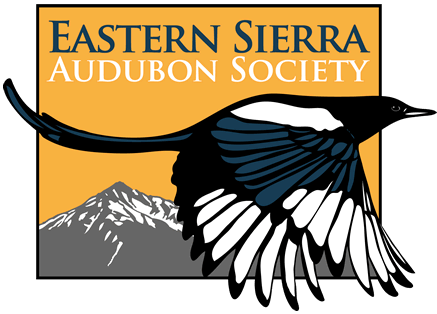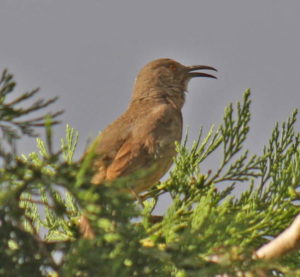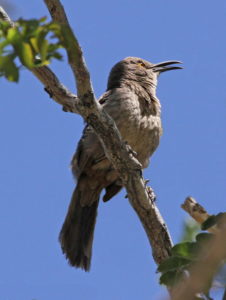Rick Scott, a long time resident of Starlite and a non-birder, heard a song in his yard on 11 June 2012 that was new to him. Instead of saying, “That sounds different” and continuing with his yard work he searched for it and found it in the top of a tree at the edge of his property. It was a medium large bird with a long decurved bill, singing his heart out. Rick called to Karen, his wife, “Quick, come here! I’ve got a bird that I’ve never seen before!” Karen grabbed her camera and began taking pictures of this avian surprise before it flew away. Step 1, recognizing that something is out of the ordinary, and Step 2, gathering evidence, were over in about ten minutes.
Rick is a herpetologist, someone who studies reptiles and amphibians, and intellectually curious…a dynamite combination. He applied his years of training to a new field, birds, and began the research (Step 3) necessary to determine what he saw. Almost all biologists have a specialty but while in the field looking for their targets, be they animals or plants, they are constantly bumping into other interesting forms of fauna and over the years develop a wide breadth of general field biology knowledge. Rick thought he knew what family the bird was in based on the beautiful song, long decurved bill, and unremarkable brownish-gray plumage. In looking at The Sibley Guide to Birds, he went to the thrashers and looked at each species carefully, eliminating them one by one on one characteristic or another–wrong eye color, wrong bill size and shape, wrong undertail coverts, etc. He decided that it was a Curve-billed Thrasher. When he looked at the map he saw that it is a resident of Mexico, southern Arizona, southern New Mexico, western Texas, and north barely into southeastern Utah and southwestern Colorado. There were a few green dots in southwestern California indicating a few extralimital records have occurred in the state but nothing up in the Inyo County area. There was one dot in eastern Nevada and another in southern Idaho hinting at the fact that this species has very rarely occurred north of the southern boundary of the western States. Still questioning himself, he went online to search for bird vocalizations where he found songs of all the birds at the Cornell Lab of Ornithology website. He played all the thrashers and he and Karen agreed that the song most similar to ‘their’ bird was a Curve-billed Thrasher. After determining its identity, based on his research and limited experience, he took Step 4 and looked for additional help and collaboration. He went to the Eastern Sierra Birds website to find the e-address for the people who have developed a graph booklet of bird distribution in Inyo County that he saw referenced numerous times and emailed his wife’s pictures and his description of the event. When we open a post by a person unknown to us, we are always wary…then Jon Dunn arrived and, based on the images, confirmed that Rick & Karen Scott had a Curve-billed Thrasher in their yard…then the race began. Because of privacy factors for this small mountain village, a decision was made to not put the sighting out globally but to let a few people tell a few of their friends. We’ve been part of events like this where 50-100 cars with 100-200 people show up and common sense by a few inconsiderate birders disappears and the area is closed to birders forever. So the ripple-effect of bad behavior by a few birders far from here was the reason for the exclosure decision. Sad, but in the Eastern Sierra, neighbors take care of neighbors. Over the next week, two to a dozen people wandered the five short streets, meeting the welcoming residents who were thrilled that such a special bird was found in their special paradise! Most birders were able to find the bird, sometimes after hours of walking, but a few were not so lucky. The last day for which there is documentation is 23 June although residents say they have heard the bird occasionally to the end of July. This is the first Inyo County record and the northernmost California record but the state has 28 records, not counting this one, with all but three along the Colorado River, from Lake Havasu south, and from the Salton Sea south to the Mexican border. The three ‘northern’ records were at Huntington Beach, Montebello, and El Monte.But, it was not over for Rick! The final step was to formalize his sighting by writing documentation to accompany Karen’s images and submit the evidence to the California Bird Records Committee for review. All the documentation written by other observers will also be included in the review package. Because of the photographs, which clearly show that it isn’t only a Curve-billed Thrasher but a bird of the race palmeri, this will be an easy sighting for the Committee to accept as a state record.

Curve-bill Thrasher
last seen in Starlite Estates on August 12th
Photo by Rick Scott
EPILOGUE: The Curve-billed Thrasher lingered through 12 August with a 9 August image to substantiate its continuing presence in Starlite, photographed at the home of Rick and Karen Scott, where this saga began.
Tags: owl, thrasher




